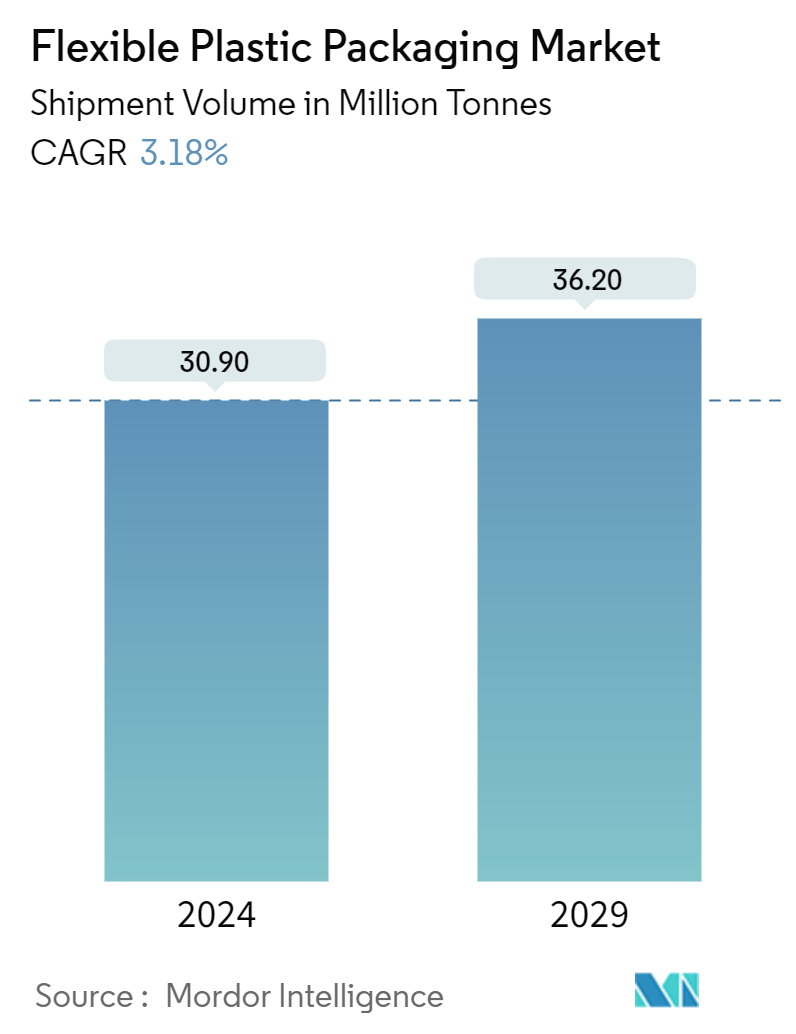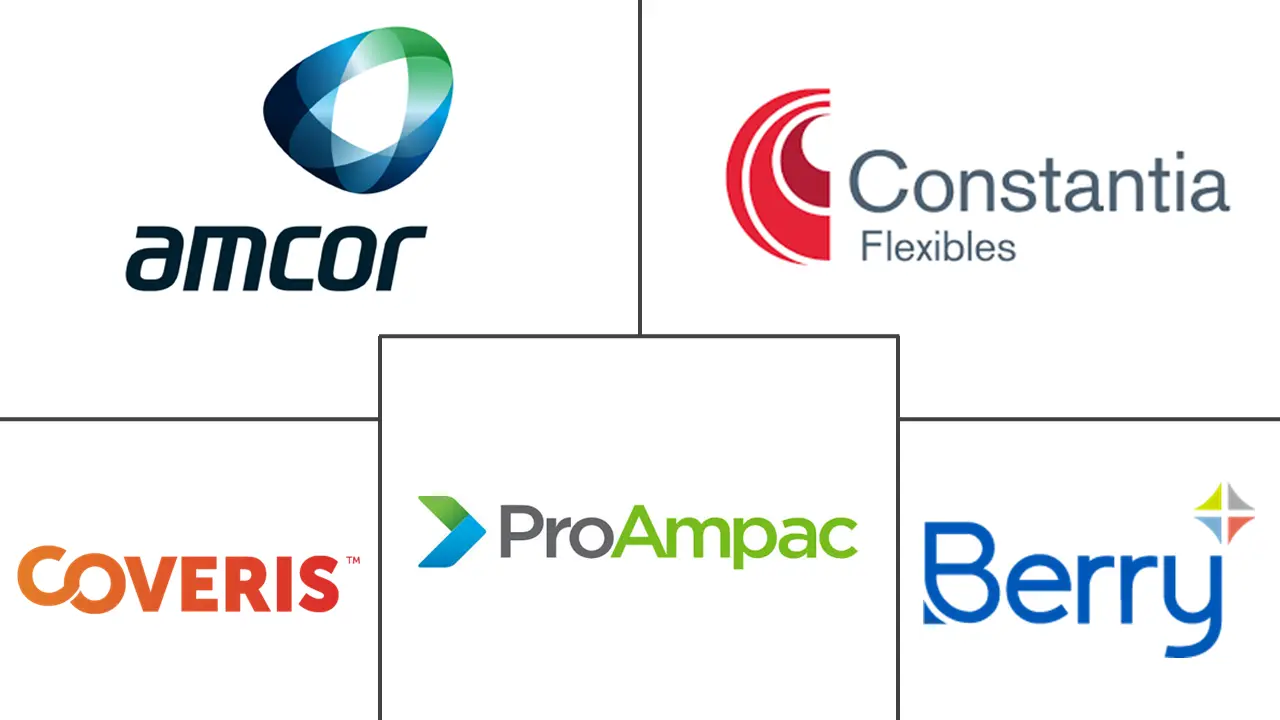Market Size of Flexible Plastic Packaging Industry

| Study Period | 2019 - 2029 |
| Market Volume (2024) | 30.90 Million tonnes |
| Market Volume (2029) | 36.20 Million tonnes |
| CAGR (2024 - 2029) | 3.18 % |
| Fastest Growing Market | Asia Pacific |
| Largest Market | Asia Pacific |
| Market Concentration | Low |
Major Players
*Disclaimer: Major Players sorted in no particular order |
Flexible Plastic Packaging Market Analysis
The Flexible Plastic Packaging Market size in terms of shipment volume is expected to grow from 30.90 Million tonnes in 2024 to 36.20 Million tonnes by 2029, at a CAGR of 3.18% during the forecast period (2024-2029).
The flexible plastic packaging market is driven by a combination of factors, including increasing demand for convenient and lightweight packaging solutions, the need for barrier-resistant packaging solutions, and advancements in packaging technology for improved shelf life and product protection.
- Higher retail sales push manufacturers to create attractive packaging. Flexible plastic packaging allows for creative designs that help products stand out on shelves and catch consumer attention. Retail sales in the United States reached USD 7,242.56 billion in 2023, up from USD 5,396.59 billion in 2019, according to the United States Census Bureau.
- More retail sales often lead to the market's growth, with new products entering the market and existing ones reaching more people. Flexible plastic packaging works well for different product categories, including food, beverages, pharmaceuticals, and personal care. Its ability to fit various shapes and sizes, cost-effectiveness, and ease of transport also boost its growth, especially with rising retail sales.
- The government's plan to set up technology hubs focused on polymer research and sustainable materials is set to change the flexible plastic packaging industry. With significant R&D funding, these hubs aim to improve materials science, leading to more sustainable, cost-effective, and high-performance packaging solutions.
- By October 2024, the US government would allocate resources to over two dozen technology hubs, focusing on research and development, especially polymers like plastics, to find sustainable materials and processes that will benefit the flexible plastic packaging sector.
- However, the flexible plastic packaging market faces a significant challenge: growing concerns about plastic waste. Packaging is the most critical contributor to global single-use plastic waste, with 36% of all plastics used in this sector. This highlights the urgent need for the industry to innovate and create more sustainable alternatives to reduce environmental impact and meet consumer demands for eco-friendly solutions.
Flexible Plastic Packaging Industry Segmentation
Flexible plastic packaging optimizes sustainability, product safety during transit and storage, and space efficiency by blending film and plastic materials. The study covers the flexible packaging market tracked in terms of consumption and is limited to flexible packaging products made from plastic. The study analyzes the factors that impact geopolitical developments in the studied market based on the prevalent base scenarios, key themes, and end-user industries-related demand cycles. The study also tracks the key market parameters, underlying growth influencers, and major vendors operating in the industry, which supports the market estimations and growth rates during the forecast period.
The Flexible Plastic Packaging Market Report is Segmented by Material (Polyethene [PE], Bi-Oriented Polypropylene [BOPP], Cast Polypropylene [CPP], Polyvinyl Chloride [PVC], Ethylene Vinyl Alcohol [EVOH], and Other Material Types [Polycarbonate, PHA, PLA, Acrylic, and ABS]), Product Type (Pouches, Bags, Films and Wraps, and Other Product Types), End-User Industry (Food [Frozen Food, Dry Food, Meat, Poultry, and Sea Food, Candy & Confectionery, Pet Food, Dairy Products, Fresh Produce and Other Food (Seasonings & Spices, Spreadables, Sauces, Condiments, etc.)], Beverage, Medical and Pharmaceutical, Personal Care and Household Care, and Other End User Industry [Automotive, Chemical, Agriculture ]), and Geography (North America [United States and Canada], Europe [France, Germany, Italy, United Kingdom,Spain, Poland, Nordic and Rest of Europe], Asia-Pacific [China, India, Japan, Thailand, Indonesia, Vietnam, Australia and New Zealand, and Rest of Asia-Pacific], Latin America [Brazil, Mexico, Argentina, and Rest of Latin America], and Middle East and Africa [United Arab Emirates, Saudi Arabia, Egypt, South Africa, Nigeria, Morocco and Rest of Middle East and Africa]). The report offers market forecasts and size in volume (tonnes) for all the above segments.
| By Material Type | |
| Polyethene (PE) | |
| Bi-oriented Polypropylene (BOPP) | |
| Cast Polypropylene (CPP) | |
| Polyvinyl Chloride (PVC) | |
| Ethylene Vinyl Alcohol (EVOH) | |
| Other Material Types (Polycarbonate, PHA, PLA, Acrylic, and ABS) |
| By Product Type | |
| Pouches | |
| Bags | |
| Films and Wraps | |
| Other Product Types |
| By End-User Industry | ||||||||||
| ||||||||||
| Beverage | ||||||||||
| Medical and Pharmaceutical | ||||||||||
| Personal Care and Household Care | ||||||||||
| Other End user Industries ( Automotive, Chemical, Agriculture) |
| By Geography*** | |||||||||
| |||||||||
| |||||||||
| |||||||||
| |||||||||
|
Flexible Plastic Packaging Market Size Summary
The flexible plastic packaging market is poised for significant growth, driven by the increasing demand for convenient, lightweight, and barrier-resistant packaging solutions. This growth is fueled by advancements in packaging technology that enhance shelf life and product protection. The market's expansion is further supported by the rising retail sales, which encourage manufacturers to create visually appealing packaging that captures consumer attention. Flexible plastic packaging's versatility makes it suitable for various product categories, including food, beverages, pharmaceuticals, and personal care, contributing to its widespread adoption. However, the industry faces challenges related to plastic waste, prompting a push towards sustainable alternatives and innovations in materials science.
The market is characterized by a fragmented landscape with numerous global players, such as Berry Global Group, Amcor Group GmbH, and Constantia Flexibles Group GmbH, who are actively developing innovative packaging solutions and pursuing strategic acquisitions to maintain competitiveness. The introduction of sustainable materials, like BOPP films, highlights the industry's commitment to reducing environmental impact while meeting consumer demands for eco-friendly options. The growing popularity of plant-based diets and the shift towards convenience-oriented consumer habits further underscore the importance of flexible plastic packaging in ensuring product quality and extending shelf life. As the market evolves, collaborations and technological advancements are expected to play a crucial role in shaping the future of flexible plastic packaging.
Flexible Plastic Packaging Market Size - Table of Contents
-
1. MARKET INSIGHTS
-
1.1 Market Overview
-
1.2 Industry Attractiveness - Porter's Five Forces Analysis
-
1.2.1 Bargaining Power of Suppliers
-
1.2.2 Bargaining Power of Buyers
-
1.2.3 Threat of New Entrants
-
1.2.4 Threat of Substitutes
-
1.2.5 Intensity of Competitive Rivalry
-
-
1.3 Industry Value Chain Analysis
-
-
2. MARKET SEGMENTATION
-
2.1 By Material Type
-
2.1.1 Polyethene (PE)
-
2.1.2 Bi-oriented Polypropylene (BOPP)
-
2.1.3 Cast Polypropylene (CPP)
-
2.1.4 Polyvinyl Chloride (PVC)
-
2.1.5 Ethylene Vinyl Alcohol (EVOH)
-
2.1.6 Other Material Types (Polycarbonate, PHA, PLA, Acrylic, and ABS)
-
-
2.2 By Product Type
-
2.2.1 Pouches
-
2.2.2 Bags
-
2.2.3 Films and Wraps
-
2.2.4 Other Product Types
-
-
2.3 By End-User Industry
-
2.3.1 Food
-
2.3.1.1 Candy & Confectionery
-
2.3.1.2 Frozen Foods
-
2.3.1.3 Fresh Produce
-
2.3.1.4 Dairy Products
-
2.3.1.5 Dry Foods
-
2.3.1.6 Meat, Poultry, and Sea Food
-
2.3.1.7 Pet Food
-
2.3.1.8 Other Food Products (Seasonings & Spices, Spreadables, Sauces, Condiments, etc.)
-
-
2.3.2 Beverage
-
2.3.3 Medical and Pharmaceutical
-
2.3.4 Personal Care and Household Care
-
2.3.5 Other End user Industries ( Automotive, Chemical, Agriculture)
-
-
2.4 By Geography***
-
2.4.1 North America
-
2.4.1.1 United States
-
2.4.1.2 Canada
-
-
2.4.2 Europe
-
2.4.2.1 France
-
2.4.2.2 Germany
-
2.4.2.3 Italy
-
2.4.2.4 United Kingdom
-
2.4.2.5 Spain
-
2.4.2.6 Poland
-
2.4.2.7 Nordic
-
-
2.4.3 Asia-Pacific
-
2.4.3.1 China
-
2.4.3.2 India
-
2.4.3.3 Japan
-
2.4.3.4 Thailand
-
2.4.3.5 Australia and New Zealand
-
2.4.3.6 Indonesia
-
2.4.3.7 Vietnam
-
-
2.4.4 Latin America
-
2.4.4.1 Brazil
-
2.4.4.2 Mexico
-
2.4.4.3 Colombia
-
-
2.4.5 Middle East and Africa
-
2.4.5.1 United Arab Emirates
-
2.4.5.2 Saudi Arabia
-
2.4.5.3 Egypt
-
2.4.5.4 South Africa
-
2.4.5.5 Nigeria
-
2.4.5.6 Morocco
-
-
-
Flexible Plastic Packaging Market Size FAQs
How big is the Flexible Plastic Packaging Market?
The Flexible Plastic Packaging Market size is expected to reach 30.90 million tonnes in 2024 and grow at a CAGR of 3.18% to reach 36.20 million tonnes by 2029.
What is the current Flexible Plastic Packaging Market size?
In 2024, the Flexible Plastic Packaging Market size is expected to reach 30.90 million tonnes.

